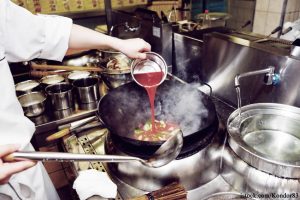The Salmonella outbreaks at the Fig & Olive restaurant in Washington, D.C. and Chipotle restaurants in Minnesota are not uncommon. Just in the last year, there have been six other Salmonella outbreaks linked to restaurants in the United States.
 Contaminated cucumbers sold in salads at Red Lobster restaurants in Minnesota sickened many people with Salmonella infections this summer. A Salmonella outbreak linked to the deli at the Boise Co-op in Idaho this summer sickened almost 300 people. A Salmonella outbreak at Seattle’s Tallulah restaurant sickened at least 16 people in July, linked to a sauce made from raw eggs. An outbreak at the Tarheel Q restaurant in North Carolina in June and July sickened almost 200 people. A Salmonella outbreak at the X10 restaurant in Dalhart, Texas last spring sickened 64 people. And at least 19 people eating at the Delaney House restaurant in Massachusetts last winter were sickened with Salmonella infections.
Contaminated cucumbers sold in salads at Red Lobster restaurants in Minnesota sickened many people with Salmonella infections this summer. A Salmonella outbreak linked to the deli at the Boise Co-op in Idaho this summer sickened almost 300 people. A Salmonella outbreak at Seattle’s Tallulah restaurant sickened at least 16 people in July, linked to a sauce made from raw eggs. An outbreak at the Tarheel Q restaurant in North Carolina in June and July sickened almost 200 people. A Salmonella outbreak at the X10 restaurant in Dalhart, Texas last spring sickened 64 people. And at least 19 people eating at the Delaney House restaurant in Massachusetts last winter were sickened with Salmonella infections.
Eating or drinking at these restaurants is obviously the common link between all who got sick. But how does the food become contaminated in the first place, and how do investigators solve these outbreaks?
When an outbreak occurs at several restaurants that are part of a chain, investigators look at the food that is common to all of them. Fresh produce is suspected in the Salmonella outbreak at Minnesota Chipotle restaurants. The produce used in those restaurants is traced back to a supplier. Environmental testing is conducted at that facility and in the restaurants to try to pinpoint the bacterial source.
Public health officials interview patients to see what foods they ate at the restaurant and ask them to list other things they ate before they got sick. A questionnaire is usually sent out to patients. This tactic can narrow down the foods officials test. If a common food is statistically tied to the outbreak, traceback investigations look at the supplier and sources.
Outbreaks at an individual restaurant can be more difficult to solve. Officials concentrate on the foods eaten by patients, and look at the employees to see if any of them were working while sick. Environmental testing is also conducted. Investigators take swabs of the kitchen, serving trays, the dining room, and utensils to see if any were contaminated. They also investigate how food is held and served, and if any food safety regulations, such as temperature or storage, have been violated.
If you ate at the Fig & Olive restaurant in Washington D.C., at Chipotle restaurants or Red Lobster restaurants in Minnesota and have experienced the symptoms of Salmonella food poisoning, see your doctor. Ask for a stool sample test and tell her that you ate at one of these restaurants.
Those symptoms include nausea, vomiting, abdominal pain, diarrhea that may be bloody, fever, chills, headache, and muscle pains. The symptoms begin six to seventy-two hours after exposure to the pathogenic bacteria. Most people recover within four to seven days, but some people must be hospitalized because their illness is so severe.
There is really no way to protect yourself against food poisoning from restaurants. Just note the cleanliness of the place before you order. Watch out for signs of problems such as a dirty floor or unclean utensils. And if you do get sick after eating at a restaurant, see your doctor for help.




